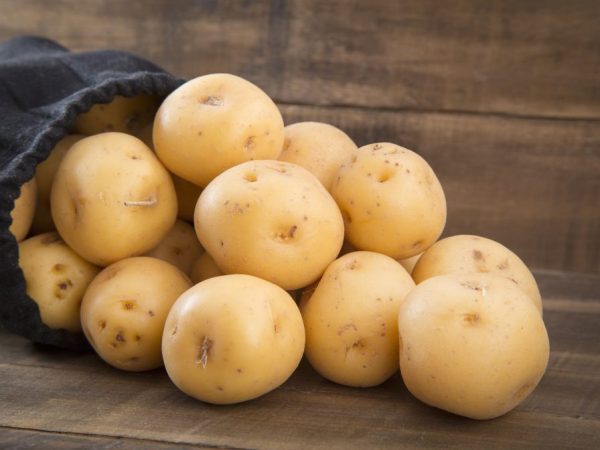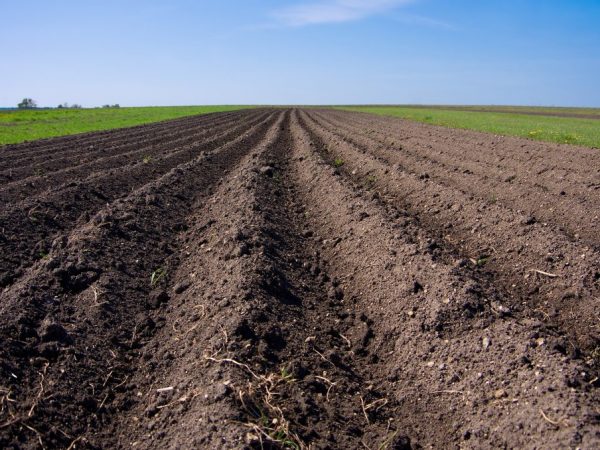Characteristics of Vega potatoes
Vega potatoes are an early variety that is always popular among many gardeners. This varietal variety of potatoes is grown both for personal use and for sale. The advantage of this nightshade crop is its versatility when grown. Due to the observance of all the rules of agricultural technology, Vega potatoes can be grown even by novice vegetable growers.

Characteristics of Vega potatoes
Description of the variety
The Vega potato variety gives a high yield, according to average indicators, from seven to nine large potatoes are harvested from one bush. The tuber is medium in size, round-oval in shape, weighing from 85 to 100 g.
Vega has a small size of bushes, erect stems, sometimes semi-erect. The leaves are simple in shape with a dark green tint, the edges are slightly wavy. The bush is characterized by an average degree of foliage. The flowers are collected in corollas, are large in size, the shade is white-cream.
Advantages and disadvantages
The characteristic of the Vega variety is distinguished by many quality indicators.
This proves that the Vega potato variety has some advantages over other Varietal potato varieties.
Vega seed potatoes have a number of advantages:
- excellent taste;
- high yield (from 230 to 375 centners per hectare);
- tubers have a thin peel with few eyes;
- large fruits of a non-watery dry structure;
- on average, the starch content is from 10 to 16%;
- simultaneous ripening of tubers;
- keeping quality is about 99%;
- the variety is universal for long-distance transportation;
- resistance to various viral diseases, common scab, cancerous growths on the surface of tubers, as well as to tobacco mosaic.
The disadvantages of this vegetable include sensitivity to watering. Like many representatives of nightshade crops, this varietal variety is characterized by a defeat by the Colorado potato beetle.
Landing
The Vega potato variety does not require special agrotechnical skills, as it easily tolerates temperature fluctuations and changes in humidity. Experienced vegetable growers recommend that you first germinate the tubers, and then warm them up.
Germination rules:
- Choose healthy tubers with a flat surface, free from signs of disease.
- Install special shelving structures or containers in a well-lit room, where the air temperature is from 15 to 17 ˚ С.
- Lay the potatoes in layers in the prepared area.
- In order for the tubers to germinate evenly, it is necessary to rearrange the boxes from time to time.
The first shoots appear after 21 days. You should also harden the sprouted tubers, for this you need to periodically carry out a sharp change in temperature conditions (decrease by 6-8 ° C).This method helps to activate the gost of eyes and is a guarantee of simultaneous germination of tubers and a high yield.
Soil preparation
Qualitative indicators of the yield of Vega potatoes are observed when planting sprouted tubers on light sandy soils. For effective fruiting, the soil must be properly prepared.
Features of site preparation:
- Choose a dry place for planting tubers.
- Loosen the soil.
- Pour a small amount of wood ash and compost substrate into each hole.
It is recommended to sow in the middle of September on the site where potatoes, siderates (rye, barley, wheat) will be grown.

The soil must be properly prepared
Such cereal grasses will help enrich the soil with useful trace elements in the process of its own decay. You can also in some cases use ready-made fertilizer solutions for nightshade crops. In autumn, the soil should not be broken into clods. Soil fractions of a large size will freeze better in winter, and together with them, most of the weed seeds will be destroyed.
Planting
The characteristic of Vega potatoes implies a medium early planting of sprouted tubers - late April or early May. At this time, the soil warms up well, which contributes to the further effective growth of tubers.
Planting rules:
- Discard tubers without sprouts or with sluggish thin sprouts, as well as small potatoes weighing less than 30 g.
- Planting depth - 10-12 cm.
- Dig holes in steps of 35 to 38 cm.
- The distance between the rows is from 70 to 75 cm.
- Place tubers in the holes and cover with fertile soil.
The growing season for this varietal variety is 60 to 69 days. According to the reviews of experienced vegetable growers, there is no need to water after planting the tubers.
Care
For the entire growing season, it is recommended to huddle the bushes at least twice. It is also necessary to ensure that weeds do not spread, for this you need to carry out regular weeding of the plants.
Weed control can be done manually. It is also possible to use herbicidal preparations, which are an effective way of killing weeds.
Watering
Vega potatoes are very sensitive to watering, therefore it is recommended infrequently, but abundantly, to moisten the soil. To get a high yield, moisture must saturate the soil by 40-45 cm.
The best solution to ensure proper irrigation is drip irrigation. Using this moisturizing method, moisture will flow directly to the tubers, which will have a positive effect on yields.
Fertilizer
Throughout the growing season, potatoes should be fertilized; it is recommended to carry out two dressings. At the first feeding during the period of tops development and the formation of tuberous groups, ammonium nitrate or a weak urea solution is used.
For the second feeding, potassium sulfate or superphosphate fertilizers are used. Also, after the flowers have appeared and before the initial stage of wilting of the tops, mineral fertilizers should be applied. No further fertilization is required.
Pest control
This variety needs pest control. When plants are damaged by the Colorado potato beetle, various methods of control are used, including mechanical destruction of pests after manual assembly.
Bushes are treated with such solutions:
- chemical preparations Sonnet, Regent;
- herbal tinctures of celandine and acacia.
Also, some gardeners carry out dusting of the bushes. To do this, wood ash is poured into the bucket and with the help of a broom all the bushes are sprinkled, even those on which there are no Colorado beetles. Dusting can be done using a conventional sieve.
Often tubers can be damaged by wireworms, therefore, when planting, it is recommended to fill in three to four granules of superphosphate fertilizer into the hole, which are previously sprayed with insecticidal preparations.
As a natural way to prevent nightshade pests, you can plant crops such as alfalfa or mustard. According to vegetable growers, crop rotation is important, potatoes are planted after root crops. This variety is not recommended to be planted after tomatoes, as both types of nightshade crops are attacked by the same pests.
Conclusion
The description says that the seed potato Vega is a versatile variety of nightshade crops. The vegetable has excellent taste and is used in the preparation of dietary meals. It is best to store the vegetable in small containers that can hold up to two buckets of potatoes. This storage method will avoid injury to potatoes, as well as the appearance of infectious processes (wet rot).
You should buy planting material in specialized agrotechnical stores. Poor-quality potatoes purchased in the autumn may not last until they are planted on the site.


